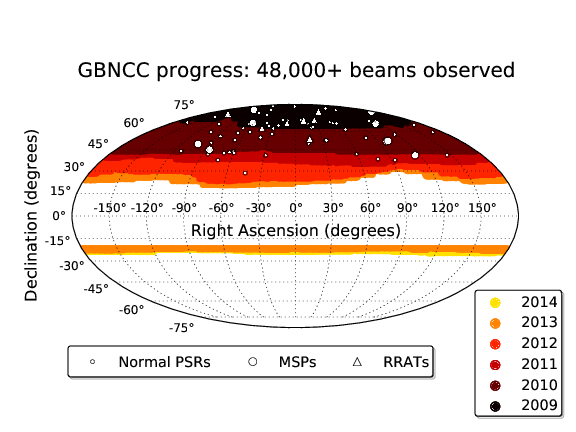Daily Image
04-07-2014The GBNCC pulsar survey
| Submitter: | Anne Archibald |
| Description: | Pulsars are fascinating objects, radio-emitting neutron stars spinning as fast as hundreds of times per second. They have been used to study theories of gravity, supernova explosions, and the interstellar medium. Currently there is an international effort to use them to detect for the first time the gravitational waves predicted by Einstein's theory of gravity. But to do this we must find more stable, fast-spinning pulsars. The best way to do this is to systematically scan a telescope over the whole sky searching for radio pulsations from each direction. This paper describes one such very effective search, the Green Bank North Celestial Cap (GBNCC) survey. The GBNCC survey is carried out with the Robert C. Byrd telescope in Green Bank, West Virginia. This is a huge 100m by 110m single dish that can be pointed anywhere in the sky. We are observing at 350 MHz, where pulsars are very bright and where the beam covers about a degree of sky. The goal is, between this and the similar Green Bank drift scan survey, to survey the entire sky visible from Green Bank. So far the GBNCC survey has carried out more than 48000 pointings (see image), with more being observed as this is being written. The drift scan survey found many pulsars, including several fascinating and exotic systems, and the GBNCC is finding many more. The GBNCC is run by a worldwide group of astronomers, including ASTRON's own Jason Hessels, Vlad Kondratiev, and Anne Archibald. Follow-up of the discovered pulsars is being carried out with many telescopes, including Westerbork and LOFAR. LOFAR's multi-beaming capability makes the telescope unique in its ability to localize rotating radio transients. |
| Copyright: | Kevin Stovall |
| Tweet |  |
